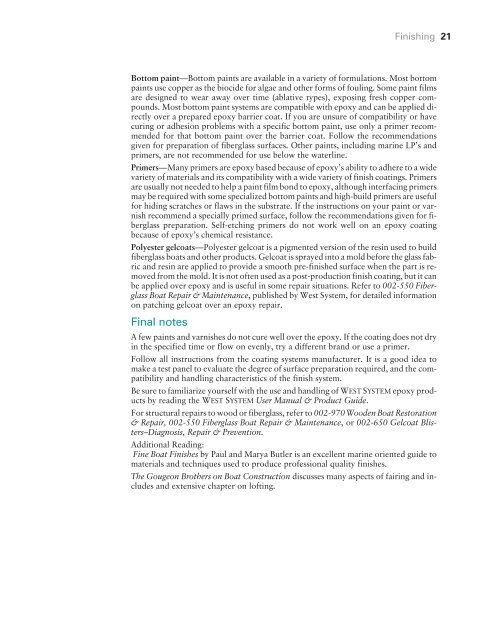Final Fairing & Finishing - WEST SYSTEM Epoxy
Final Fairing & Finishing - WEST SYSTEM Epoxy
Final Fairing & Finishing - WEST SYSTEM Epoxy
You also want an ePaper? Increase the reach of your titles
YUMPU automatically turns print PDFs into web optimized ePapers that Google loves.
Bottom paint—Bottom paints are available in a variety of formulations. Most bottom<br />
paints use copper as the biocide for algae and other forms of fouling. Some paint films<br />
are designed to wear away over time (ablative types), exposing fresh copper compounds.<br />
Most bottom paint systems are compatible with epoxy and can be applied directly<br />
over a prepared epoxy barrier coat. If you are unsure of compatibility or have<br />
curing or adhesion problems with a specific bottom paint, use only a primer recommended<br />
for that bottom paint over the barrier coat. Follow the recommendations<br />
given for preparation of fiberglass surfaces. Other paints, including marine LP’s and<br />
primers, are not recommended for use below the waterline.<br />
Primers—Many primers are epoxy based because of epoxy’s ability to adhere to a wide<br />
variety of materials and its compatibility with a wide variety of finish coatings. Primers<br />
are usually not needed to help a paint film bond to epoxy, although interfacing primers<br />
may be required with some specialized bottom paints and high-build primers are useful<br />
for hiding scratches or flaws in the substrate. If the instructions on your paint or varnish<br />
recommend a specially primed surface, follow the recommendations given for fiberglass<br />
preparation. Self-etching primers do not work well on an epoxy coating<br />
because of epoxy’s chemical resistance.<br />
Polyester gelcoats—Polyester gelcoat is a pigmented version of the resin used to build<br />
fiberglass boats and other products. Gelcoat is sprayed into a mold before the glass fabric<br />
and resin are applied to provide a smooth pre-finished surface when the part is removed<br />
from the mold. It is not often used as a post-production finish coating, but it can<br />
be applied over epoxy and is useful in some repair situations. Refer to 002-550 Fiberglass<br />
Boat Repair & Maintenance, published by West System, for detailed information<br />
on patching gelcoat over an epoxy repair.<br />
<strong>Final</strong> notes<br />
<strong>Finishing</strong> 21<br />
A few paints and varnishes do not cure well over the epoxy. If the coating does not dry<br />
in the specified time or flow on evenly, try a different brand or use a primer.<br />
Follow all instructions from the coating systems manufacturer. It is a good idea to<br />
make a test panel to evaluate the degree of surface preparation required, and the compatibility<br />
and handling characteristics of the finish system.<br />
Be sure to familiarize yourself with the use and handling of <strong>WEST</strong> <strong>SYSTEM</strong> epoxy products<br />
by reading the <strong>WEST</strong> <strong>SYSTEM</strong> User Manual & Product Guide.<br />
For structural repairs to wood or fiberglass, refer to 002-970 Wooden Boat Restoration<br />
& Repair, 002-550 Fiberglass Boat Repair & Maintenance, or002-650 Gelcoat Blisters–Diagnosis,<br />
Repair & Prevention.<br />
Additional Reading:<br />
Fine Boat Finishes by Paul and Marya Butler is an excellent marine oriented guide to<br />
materials and techniques used to produce professional quality finishes.<br />
The Gougeon Brothers on Boat Construction discusses many aspects of fairing and includes<br />
and extensive chapter on lofting.
















